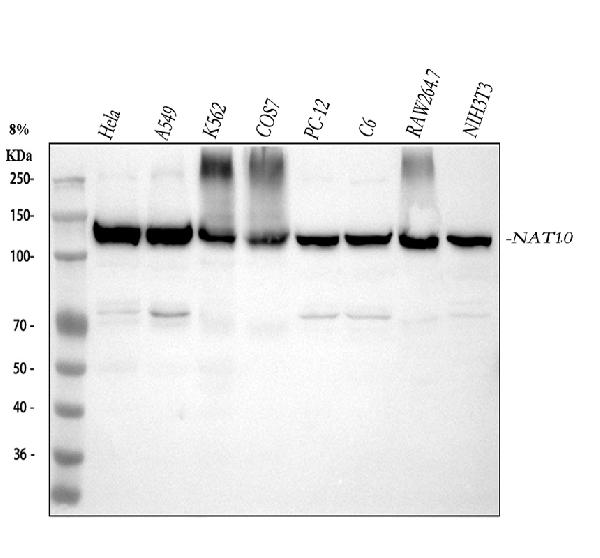Anti-NAT10 Rabbit Monoclonal Antibody
- SPECIFICATION
- CITATIONS
- PROTOCOLS
- BACKGROUND

Application
| WB, IHC, IF, ICC, IP, FC |
|---|---|
| Primary Accession | Q9H0A0 |
| Host | Rabbit |
| Isotype | IgG |
| Reactivity | Rat, Human, Mouse, Monkey |
| Clonality | Monoclonal |
| Format | Liquid |
| Description | Anti-NAT10 Rabbit Monoclonal Antibody . Tested in WB, IHC, ICC/IF, IP, Flow Cytometry applications. This antibody reacts with Human, Monkey, Mouse, Rat. |
| Gene ID | 55226 |
|---|---|
| Other Names | RNA cytidine acetyltransferase {ECO:0000255|HAMAP-Rule:MF_03211, ECO:0000303|PubMed:25411247}, 2.3.1.- {ECO:0000255|HAMAP-Rule:MF_03211, ECO:0000269|PubMed:25411247, ECO:0000269|PubMed:30449621}, 18S rRNA cytosine acetyltransferase {ECO:0000255|HAMAP-Rule:MF_03211, ECO:0000303|PubMed:25653167}, N-acetyltransferase 10 {ECO:0000255|HAMAP-Rule:MF_03211}, N-acetyltransferase-like protein, hALP, NAT10 {ECO:0000255|HAMAP-Rule:MF_03211} |
| Calculated MW | 116 kDa |
| Application Details | WB 1:500-1:2000 IHC 1:50-1:200 ICC/IF 1:50-1:200 IP 1:50 FC 1:50 |
| Contents | Rabbit IgG in phosphate buffered saline, pH 7.4, 150mM NaCl, 0.02% sodium azide and 50% glycerol, 0.4-0.5mg/ml BSA. |
| Clone Names | Clone: 26N34 |
| Immunogen | A synthesized peptide derived from human NAT10 |
| Purification | Affinity-chromatography |
| Storage | Store at -20°C for one year. For short term storage and frequent use, store at 4°C for up to one month. Avoid repeated freeze-thaw cycles. |
| Name | NAT10 {ECO:0000255|HAMAP-Rule:MF_03211} |
|---|---|
| Function | RNA cytidine acetyltransferase that catalyzes the formation of N(4)-acetylcytidine (ac4C) modification on mRNAs, 18S rRNA and tRNAs (PubMed:25411247, PubMed:25653167, PubMed:30449621, PubMed:35679869). Catalyzes ac4C modification of a broad range of mRNAs, enhancing mRNA stability and translation (PubMed:30449621, PubMed:35679869). mRNA ac4C modification is frequently present within wobble cytidine sites and promotes translation efficiency (PubMed:30449621). Mediates the formation of ac4C at position 1842 in 18S rRNA (PubMed:25411247). May also catalyze the formation of ac4C at position 1337 in 18S rRNA (By similarity). Required for early nucleolar cleavages of precursor rRNA at sites A0, A1 and A2 during 18S rRNA synthesis (PubMed:25411247, PubMed:25653167). Catalyzes the formation of ac4C in serine and leucine tRNAs (By similarity). Requires the tRNA-binding adapter protein THUMPD1 for full tRNA acetyltransferase activity but not for 18S rRNA acetylation (PubMed:25653167). In addition to RNA acetyltransferase activity, also able to acetylate lysine residues of proteins, such as histones, microtubules, p53/TP53 and MDM2, in vitro (PubMed:14592445, PubMed:17631499, PubMed:19303003, PubMed:26882543, PubMed:27993683, PubMed:30165671). The relevance of the protein lysine acetyltransferase activity is however unsure in vivo (PubMed:30449621). Activates telomerase activity by stimulating the transcription of TERT, and may also regulate telomerase function by affecting the balance of telomerase subunit assembly, disassembly, and localization (PubMed:14592445, PubMed:18082603). Involved in the regulation of centrosome duplication by acetylating CENATAC during mitosis, promoting SASS6 proteasome degradation (PubMed:31722219). Part of the small subunit (SSU) processome, first precursor of the small eukaryotic ribosomal subunit. During the assembly of the SSU processome in the nucleolus, many ribosome biogenesis factors, an RNA chaperone and ribosomal proteins associate with the nascent pre-rRNA and work in concert to generate RNA folding, modifications, rearrangements and cleavage as well as targeted degradation of pre-ribosomal RNA by the RNA exosome (PubMed:34516797). |
| Cellular Location | Nucleus, nucleolus {ECO:0000255|HAMAP- Rule:MF_03211, ECO:0000269|PubMed:12429849, ECO:0000269|PubMed:14592445, ECO:0000269|PubMed:19303003, ECO:0000269|PubMed:24786082, ECO:0000269|PubMed:25653167, ECO:0000269|PubMed:30165671, ECO:0000269|PubMed:34516797}. Midbody {ECO:0000255|HAMAP-Rule:MF_03211, ECO:0000269|PubMed:19303003} Note=Nucleolar in interphase and redistributes to the perichromosomal layer and to the midbody during telophase |

Thousands of laboratories across the world have published research that depended on the performance of antibodies from Abcepta to advance their research. Check out links to articles that cite our products in major peer-reviewed journals, organized by research category.
info@abcepta.com, and receive a free "I Love Antibodies" mug.
Provided below are standard protocols that you may find useful for product applications.
If you have used an Abcepta product and would like to share how it has performed, please click on the "Submit Review" button and provide the requested information. Our staff will examine and post your review and contact you if needed.
If you have any additional inquiries please email technical services at tech@abcepta.com.













 Foundational characteristics of cancer include proliferation, angiogenesis, migration, evasion of apoptosis, and cellular immortality. Find key markers for these cellular processes and antibodies to detect them.
Foundational characteristics of cancer include proliferation, angiogenesis, migration, evasion of apoptosis, and cellular immortality. Find key markers for these cellular processes and antibodies to detect them. The SUMOplot™ Analysis Program predicts and scores sumoylation sites in your protein. SUMOylation is a post-translational modification involved in various cellular processes, such as nuclear-cytosolic transport, transcriptional regulation, apoptosis, protein stability, response to stress, and progression through the cell cycle.
The SUMOplot™ Analysis Program predicts and scores sumoylation sites in your protein. SUMOylation is a post-translational modification involved in various cellular processes, such as nuclear-cytosolic transport, transcriptional regulation, apoptosis, protein stability, response to stress, and progression through the cell cycle. The Autophagy Receptor Motif Plotter predicts and scores autophagy receptor binding sites in your protein. Identifying proteins connected to this pathway is critical to understanding the role of autophagy in physiological as well as pathological processes such as development, differentiation, neurodegenerative diseases, stress, infection, and cancer.
The Autophagy Receptor Motif Plotter predicts and scores autophagy receptor binding sites in your protein. Identifying proteins connected to this pathway is critical to understanding the role of autophagy in physiological as well as pathological processes such as development, differentiation, neurodegenerative diseases, stress, infection, and cancer.


